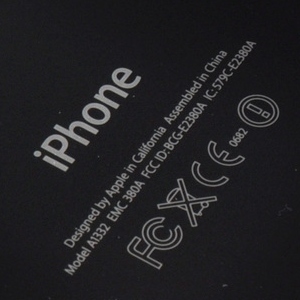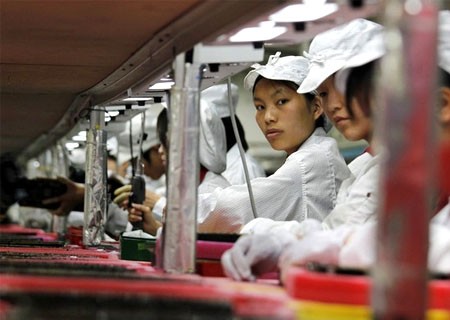Why Apple products are designed in California but assembled in China
- Transfer
 Look at the back of your iPhone, iPad, or MacBook. You will see the words “Designed by Apple in California. Assembled in China. ”Many Americans, including the president himself, wondered why Apple relocated almost all of its manufacturing facilities overseas. Last year, at a dinner party with the president and managers of major US technology companies, Obama directly asked Jobs what it would cost to return jobs to the States. According to Jobs, there is no way to do this.
Look at the back of your iPhone, iPad, or MacBook. You will see the words “Designed by Apple in California. Assembled in China. ”Many Americans, including the president himself, wondered why Apple relocated almost all of its manufacturing facilities overseas. Last year, at a dinner party with the president and managers of major US technology companies, Obama directly asked Jobs what it would cost to return jobs to the States. According to Jobs, there is no way to do this.Why doesn’t exist? Why can’t iPhones, iPads and all the other magic gadgets from Apple be made in the USA? And anyway, why can't American consumer electronics and computer companies collect more than their goods in their home country, creating new jobs and helping the economy fight the crisis?
The New York Times asked this question and, after conducting a very serious study , including conversations with former and current Apple executives, received a simple and frightening answer: iPhones do not do in America because it is impossible to make them in America. The infrastructure necessary for such production is absent. And there are not so many workers.
The Chinese factory, where the final assembly of most iPhones is made, employs 230 thousand people. I asked Siri how many cities in the United States with a population of more than this number. There are only 83 such cities. Moreover, the population is not equal to the number of working people. On average, the working-age population makes up 65 percent of the total population. It turns out that only in 50 cities of the country there is a sufficient number of working population. Moreover, even in New York, the largest American city, 230 thousand people make up 3% of the total population. Can you imagine that three out of a hundred New Yorkers sit daily at the assembly line and collect iPhones?

Over the past couple of years, we have heard enough about problems with working conditions at Foxconn factories. This Chinese company is responsible for assembling consumer electronics for most large companies, including Apple. About a quarter of these 230 thousand live in factory dormitories or barracks in the factory. That is, almost 60 thousand people live and work at the plant. Many people at Foxconn City work 6 days a week, 12 hours a day and earn less than $ 17 a day. Perhaps such conditions seem inhuman from the point of view of American standards, but workplaces at the plant are very popular. So big that Jennifer Rigoni, a former Apple supply manager, told the New York Times that Foxconn “can hire 3,000 people a day.”
These are just a couple of examples of how the scalability, speed and efficiency of Chinese manufacturing surpasses everything that manufacturing in the United States is capable of at the moment. But there are other murderous moments in the newspaper’s report. Of course, 200 thousand workers sitting at the conveyor and inserting part A into connector B can be considered unskilled labor. But the plant also has 8,700 engineers who control the process. These people cannot be considered unskilled. In this case, according to reporters from the Times, in order to find and hire so many qualified engineers in the States, it will take nine months. The Chinese hired so many engineers in 15 days.
In addition to the notable exception in the form of an A5 processor (made in Texas - translator's note)), most of the accessories for iPhones are also produced abroad. Many components are manufactured near the place of assembly of the final product. If you deliver these components for assembly at factories in the States, then additional costs will arise. And, even worse for Apple, additional delays.
Traditionally, advocates of moving industries abroad give arguments one way or another related to price. “It will be more expensive to do this in America,” they say. “You have to pay higher salaries, give bonuses, pay insurance, pay higher taxes.” Since companies work for profit, the increased cost price will certainly affect the price for buyers.
 Exaggerating, many even said that an iPhone assembled in the States would cost thousands of dollars. It turns out that this is not so. According to a New York Times study, additional salary costs for Americans will add $ 65 to the iPhone. And all other additional expenses in the amount, most likely, will not lead to the fact that a 16-gigabyte iPhone 4S will cost more than a thousand dollars without a contract. But not even the price is the main reason why Apple moved production to China. The main reason is that companies need factories where they can quickly produce as many iPhones as possible. This requires flexibility and quick adaptation to the requirements of Apple. According to one of Apple’s current managers: “The United States has stopped producing people with the skills we need.”
Exaggerating, many even said that an iPhone assembled in the States would cost thousands of dollars. It turns out that this is not so. According to a New York Times study, additional salary costs for Americans will add $ 65 to the iPhone. And all other additional expenses in the amount, most likely, will not lead to the fact that a 16-gigabyte iPhone 4S will cost more than a thousand dollars without a contract. But not even the price is the main reason why Apple moved production to China. The main reason is that companies need factories where they can quickly produce as many iPhones as possible. This requires flexibility and quick adaptation to the requirements of Apple. According to one of Apple’s current managers: “The United States has stopped producing people with the skills we need.”The Times provides a telling example from the early history of iPhones. It all happened before iPhones appeared on the market. Now it’s hard to believe it, but initially the screens of iPhones were planned to be made of plastic. Same as the iPods sold at that time. In mid-2007, a little more than a month before the first appearance of iPhones in stores, Jobs suddenly realized the stupidity of such a decision. Jobs carried an iPhone prototype in his jeans pocket, and by that time the screen of this prototype was covered with dozens of scratches. “I will not sell goods that are so scratched. I want a glass screen, and I want everything to be done perfectly in 6 weeks. ”
Anyone who knows how Jobs worked will realize that Steve was not bluffing. If the product does not meet its standards, then they will not sell it. No options. Six months of waiting for the first iPhone to appear on the shelves fueled interest to an insane level, so Apple knew that they would have to stamp iPhones as quickly as possible. And the changes in the requirements for one of the most important components, made at the last moment, meant the announcement of such an emergency that is simply impossible in American factories. Apple would be the laughing stock of all the delay. But, what would take several months in the States, took 6 weeks in China. Apple agreed with Corning to supply scratch-resistant glass, and Chinese factories were able to instantly integrate this glass into the existing iPhone design.
Apple is an American company reaping unprecedented financial success . Therefore, many Americans lament that the country has little to gain from this success. Apple employs 43,000 people in the United States. This is less than a fifth of wage workers collecting iPhones in one Chinese factory. Someone may say that Apple has succeeded in something at the expense of American workers (because it saved on them - approx. Translator ). But according to the New York Times report, it turns out that such a workforce as Apple needs in the States has never happened.
Note: the images used are Reuters and spread shirt.
